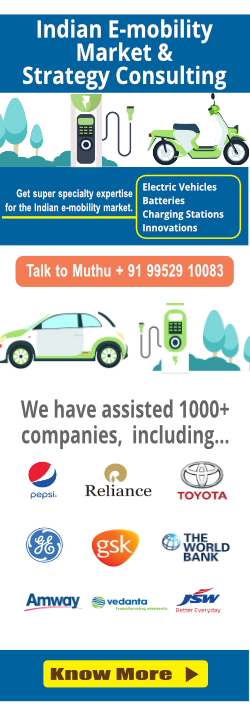![]() This post is a part of BioBiz’s Bio-CNG Perspectives.
This post is a part of BioBiz’s Bio-CNG Perspectives.
BioBiz, a division of EAI, is a leading market intelligence & strategic consulting firm for the Indian bio-based sectors.
This blog post uses the terms bio-CNG and renewable natural gas (RNG) interchangeably.
Bio-CNG or bio-compressed natural gas, also known as sustainable natural gas or biomethane, is a biogas which has been upgraded to a quality similar to fossil natural gas and having a methane concentration of 90% or greater. As the gas is derived from natural and renewable sources, it is also termed renewable natural gas (RNG).
Introduction
Logistics is a critical factor to consider while setting up renewable natural gas projects. This is because a major part of the operations involve transport of waste materials which are procured at cheaper costs (less than Rs. 2/kg). These waste materials are to be transported several kilometres (minimum 15-20 kms) to the plant. As the cost of logistics depend on the total quantum of product and distance transported and not based on the nature of product, location of the plant and the type of vehicles and business models followed can significantly contribute to the economics of the project.
It is hence essential to analyse the characteristics of a logistics value chain which assist in establishing a viable logistics model.
This blog post provides details of the RNG logistics value chain and its characteristics.
Characteristics of RNG logistics value chain
Logistics is a key factor in determining the viability of any large-scale project. In the case of RNG projects, logistics is critical as the feedstock needs to be collected from diverse locations around the city and delivered within stipulated time to the project site, within a radius of 30-35 km. In addition to feedstock collection, logistics also involves storage, segregation and pre-processing and transport of RNG cascades to industries, commercial segments or OMCs within a radius of 20-25 kms.
Logistics value chain for a RNG facility thus comprises four components –
- Inbound logistics – for feedstock procurement
- Storage
- Feedstock segregation and pre-processing
- Outbound logistics – for RNG supply
1. Inbound logistics
Inbound logistics is the first stage of the value chain. It is an important factor to consider in the case of large scale waste to energy facilities.
Inbound logistics can either be owned or third party logistics or a combination of both. Some of the logistics characteristics that can attribute to the success of RNG projects include
- Operating vehicles with higher capacity
- Tracking systems
- Trained personnel
- Timely pick up and supply of waste to the facility
- Facilities closer to the point of source
- Better storage infrastructure
- More number of vehicles for collection of feedstock from multiple locations
The waste management companies who collect organic wet waste materials from select multiple locations carry out primary segregation at source. The organic waste is then collected by a number of Tata Ace vehicles in multiple shifts from respective locations and brought to a common location to transfer the wastes to a large truck. The truck reaches the transfer station where secondary segregation of wastes is carried out. The segregated organic waste is then carried in lorries with barrels of 20-30 litre capacity (which is half filled with waste), or loaded in a huge truck and supplied to the anaerobic digestion facility.
In some cases, the waste management companies ensure complete source segregation of wet waste and directly transfer the collected wet waste in trucks to the digestion facility.
2. Storage
Storage involves facilities for stocking different types of feedstocks as well as the end products – RNG cylinders and digestate under optimal conditions.
3. Segregation and pre-processing
Segregation and pre-processing represent processes for improving the quality of feedstock to enhance digestion. The types of processes depend on the nature of feedstock. Commercial waste requires shredding and addition of water while agro waste requires extensive pre-processing techniques such as hydrolysis.
4. Outbound logistics
Outbound logistics involves transporting RNG cylinders in cascades from the manufacturing facility to the commercial/industrial units or OMC dispensing stations. Outbound logistics can either be owned or third party logistics.
Unlike inbound logistics, special care should be provided during transport of RNG cylinders owing to their flammable nature.
The following are the requirements of outbound logistics for transport of RNG cylinders as provided by Petroleum and Explosives Safety Organisation (PESO), India.
- The cylinders filled with any compressed gas shall not be transported by a bicycle or any other two wheeled mechanically propelled vehicle.
- The cylinders shall be so transported as not to project in the horizontal plane beyond the sides or ends of the vehicle by which they are transported.
- There shall be no sharp projections on the inside of the vehicle.
- The cylinders shall be adequately secured to prevent their falling off the vehicle and being subjected to rough handling, excessive shocks or local stresses.
- The cylinders transported in vehicles shall be blocked or braced and be so secured to prevent movement, striking each other or falling down.
- The cylinders filled with any compressed gas shall not be transported along with any other article of a highly flammable or corrosive nature. (source: PESO guidelines)
It could be observed that logistics value chain plays a major role in determining the operational efficiency and economics of an RNG project,
Know more on how BioBiz can assist your business in your strategy for the bio-based businesses, Here









